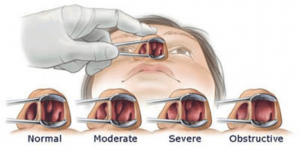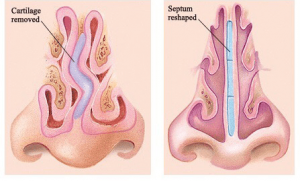A. What is Septoplasty and Turbinectomy?
This operation is performed to treat a chronically blocked nose. Your surgeon will have assessed the cause to be due to a bend in the nasal septum (plate of bone and cartilage separating your left from right nostril), and or due to enlarged turbinate’s.

Occasionally this procedure is undertaken as a part of sleep apnoea surgery to improve the nasal airway and sometimes it is done to allow access to structures deeper within the nose such as polyps or the sinuses.
B. How is it done?
You will be admitted on the day of your surgery and will stay overnight in hospital. Before the operation you will see a member of the surgical team and the anaesthetist. The operation is performed with you asleep under a general anesthetic for approximately 30 minutes to 1 hour. For the septoplasty, a small cut is made on the inside of your nose on the septum and any bent or obstructing bone/cartilage is removed or straightened. The reconstructed nasal septum is secured with internal stitches. The stitches used inside the nose are designed to dissolve on their own over a few weeks when the nose lining has healed. The turbinate’s “air-conditioning fins of the nose” may be trimmed to reduce their size.

You will wake up in the recovery room usually with some packing in the nose to prevent early post-operative bleeding. he nose is not usually very painful. After an overnight stay you will be reviewed by the surgeon in the morning and any non-dissolving nasal packing is removed (uncomfortable for a few seconds). Specific discharge instructions and postoperative appointments will be included in your discharge pack. Discharge medications will be supplied by the ward as prescribed. Medications vary but will include pain relief tablets, antibiotic tablets in some instances, and usually a saline nasal rinse to help ease the degree of crusting in the nose. Please follow the directions as per prescription.
C. What happens after Septoplasty & Turbinectomy
This is generally not a very painful operation from which to recover. For the first few weeks your nose will feel quite blocked and you will have increased mucus and some dried blood in the nose. Saline rinses may be recommended. The front of the nose may be tender from the small dissolvable sutures just inside the nostril. It is important to follow the prescribed rest period at home. Vigorous exercise should be avoided for at least 2 weeks.

